What is a marketing technologist?
A marketing technologist is a curator of the technology vision of a marketing department, from the marketing software tools it uses to how it trains teams to use them. The marketing technologist (or martech) role is relatively new — having really emerged in the 2010s — and typically senior.
Marketing technologists also go by titles like chief marketing technologist (CMT) or business information officer and serve as liaisons between an organization’s IT and marketing operations. CMTs work closely with CIOs and especially CMOs — to whom they often report — as well as with other senior members of the marketing team internally and numerous vendors externally.
Gartner has provided a helpful visualization of how CMTs usually stand in relation to other departments and marketing professionals within large companies:
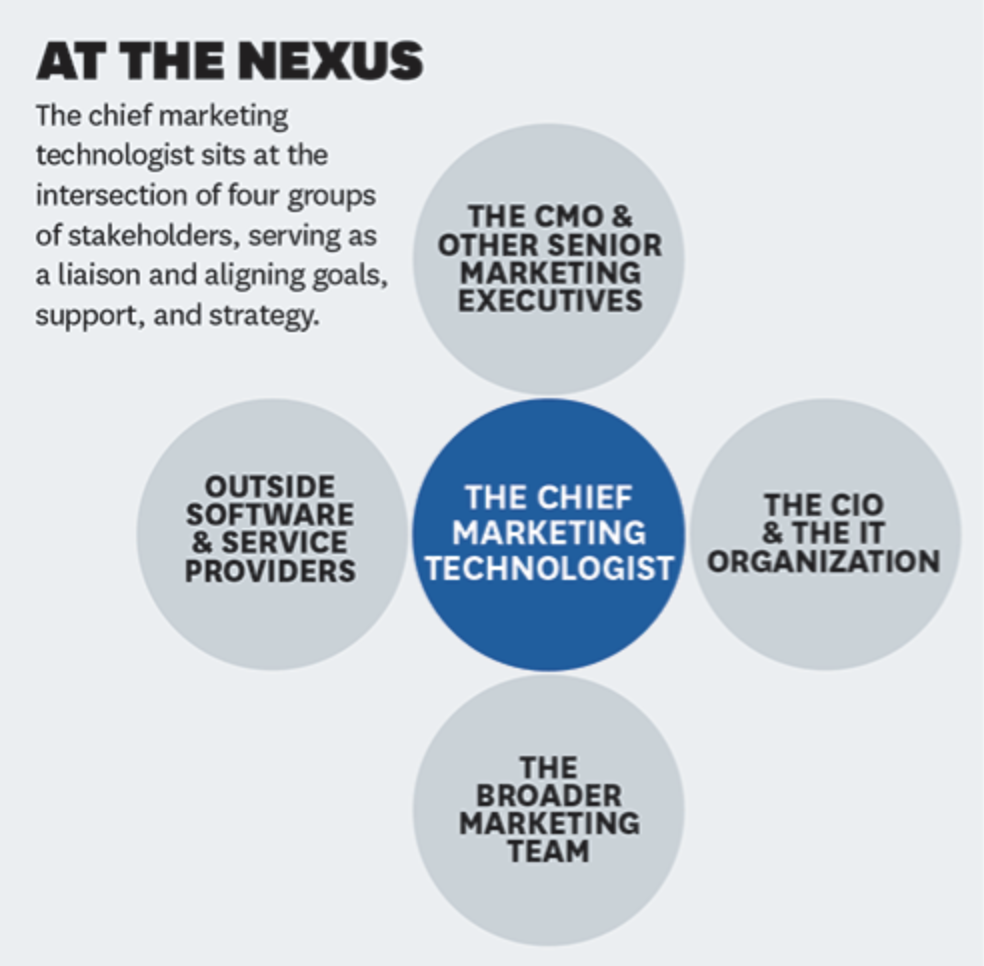
The importance of CMTs to marketing teams
For the “broader marketing team” in particular, the marketing technologist serves as a teacher, trainer, advisor, technical support provider and creative director. Basically, a CMT helps other marketers navigate the intersections of marketing and technology, drawing upon their deep knowledge in both fields.
Their expert guidance is important because marketing has become more automated, more multi-channel and overall more technologically complex over time, particularly since the 1990s. Demand for a holistic, CMT-like position bridging the marketer-IT manager divide has increased in tandem.
Indeed, marketing department hierarchies once lacked any technology-oriented roles. Instead, all technical strategy was entrusted to CIOs and CTOs, including the procurement and deployment of marketing automation platforms and analytics systems, plus any related software development.
Today, CMTs take the lead instead. Their day-to-day activities reflect the realities of a marketing industry dominated by software and by cloud computing.
A history of the marketing technologist role
Scott Brinker, the main chronicler of the evolution of the marketing technologist role, described the position as a product of the dot-com boom of the 1990s, when marketing and IT were still siloed from each other despite the growing reliance of marketing teams on online channels.
For example, Brinker described marketing teams circa 2000 needing outside agency assistance with building their websites, and more specifically in progressing through the entire process of mocking up designs in Adobe Illustrator and Photoshop and then turning those assets into something material. CMTs and the tools of their trade — like marketing automation software — arose in response.
When we look at this timeline of marketing automation platforms, we can see inflection points in both 1999 (the peak of the dot-com era, when future Oracle acquisition Eloqua launched and around the time of Brinker’s anecdote) and in 2006, when marketing software staples like Salesforce and HubSpot both began liftoff:
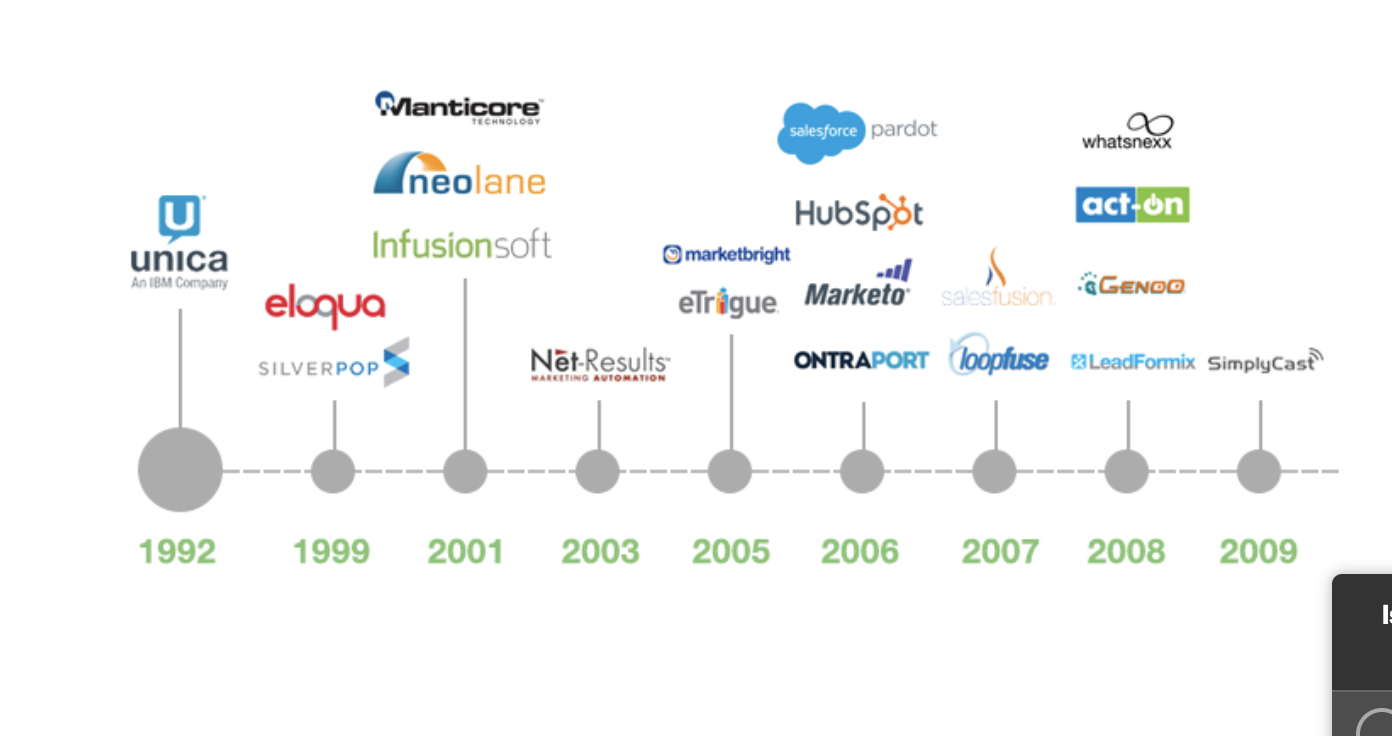
Such software has also become much more economical over time. Here’s the cost of marketing automation tools since the 1990s versus the number of vendors offering them, with 2006 again as a pivotal year:
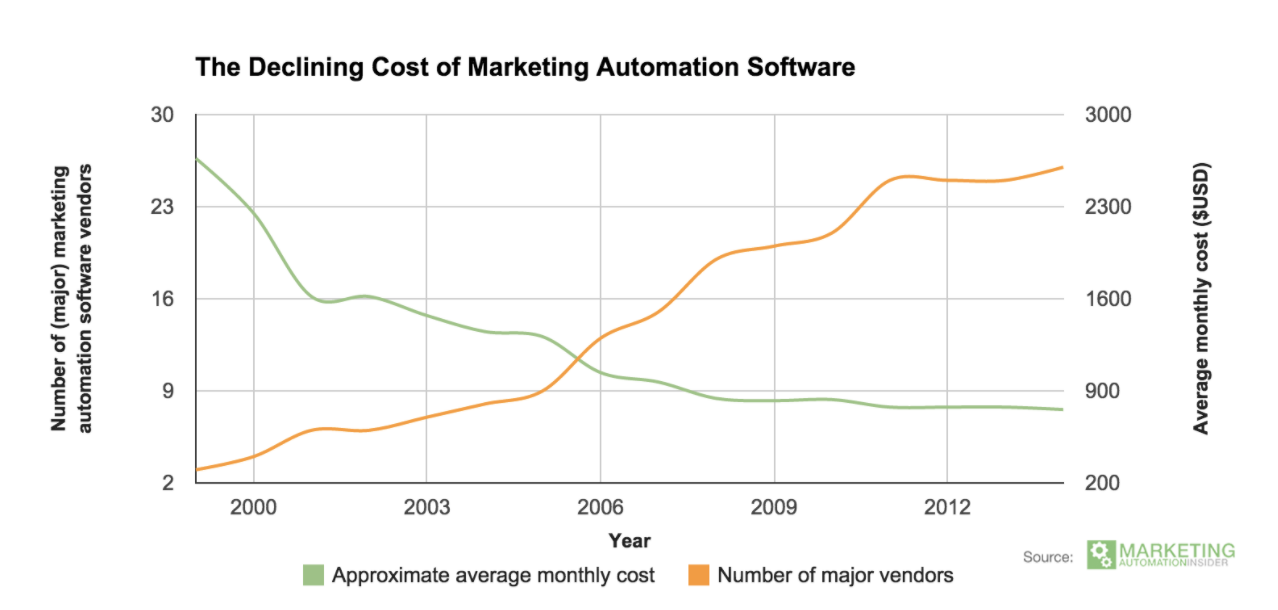
The marketing technologist role today
The modern CMT role has integrated the responsibilities that once fell to external agencies like Brinker’s into the internal operations of marketing and IT departments.
A marketing technologist helps marketing teams adapt to new tools (e.g., via training), master existing ones and generally get the most utility of the numerous applications — from email marketing products to SEO analytics suites — they rely upon.
The maturation of cloud computing (i.e., the on-demand delivery of IT resources, including marketing platforms, over an Internet Protocol network) has turbocharged the adoption of these marketing technologies and others, as many of them can now be easily accessed from any internet-enabled device and don’t require super-complex configuration.
Cloud adoption has in turn reshaped the CMT role itself. The vast range of options, all available in an instant, means that marketing technologists must be adept curators in addition to technical masters. This diagram of content marketing tools, many of them cloud-based like Adobe Creative Cloud and GoToMeeting, shows the importance of the CMT knowing which exact solutions will best support their organization’s marketing efforts.
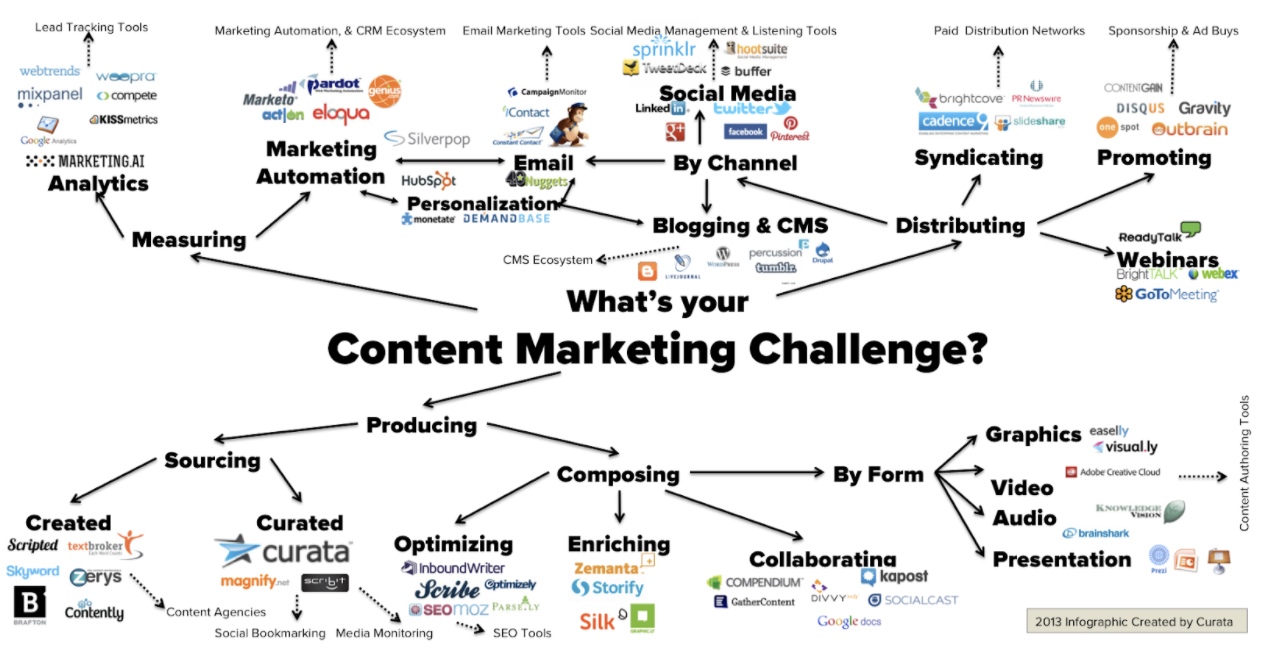
What are the main responsibilities of a marketing technologist?
What a marketing technologist does will inevitably vary by company, but typically their work spans two primary areas: one focused on software tool curation and the other on how this software is utilized in marketing initiatives. These areas can be more granularly described as “martech selection and implementation” and “brand and demand building.”
Area No.1: Martech selection and implementation
A marketing technologist may determine whether marketing teams have technical tools suited to their strategies. For example, if a marketing department is still manually tracking the KPIs (e.g., cost per lead, conversions, etc.) of a content marketing campaign in spreadsheets, a CMT may evaluate the possibility of implementing a marketing automation platform or CRM system.
Similarly, they may field marketer requests for new technology and provide recommendations, along with training and how-to guidance on integrating tools into marketing initiatives. Because many marketing technologists have an academic background in computer science plus practical experience in IT, they bring relevant knowledge to their considerations of martech vendors and to the subsequent rollout of any selected solutions.
Sorting out the marketing tool wheat from the chaff is no trivial endeavor. Consider this overview of the martech landscape as of April 2019, which includes literally thousands of solutions across sales automation, data analytics, PPC, artificial intelligence and more:
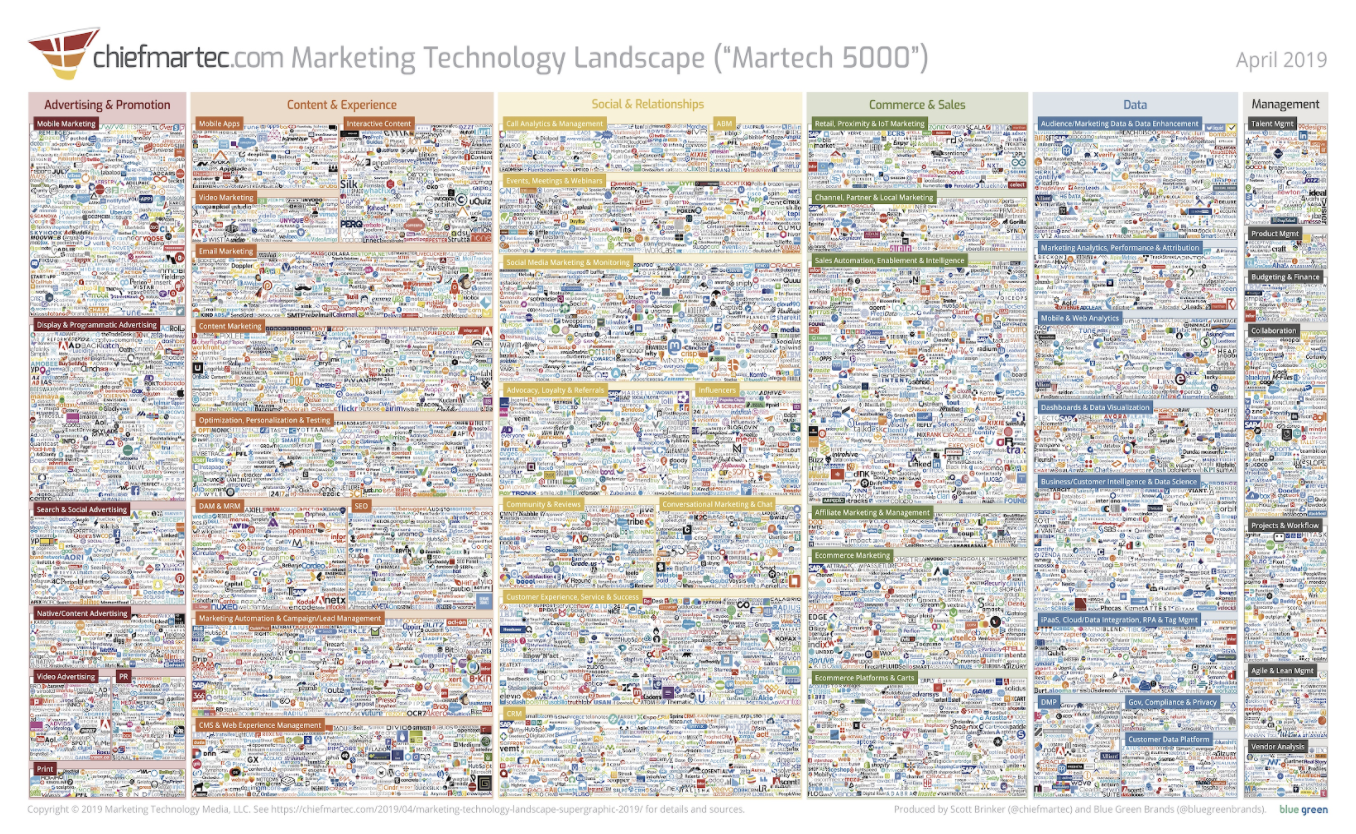
Again, curation is paramount. CMTs are ultimately responsible for reviewing, retiring, upgrading and replacing the entire marketing technology stacks at their companies. To that end, they may approve or veto purchases, solicit feedback from other marketing team members and assess potential options based on criteria like their respective cybersecurity protections and feature completeness.
Area No. 2: Brand and demand building
Marketing automation platforms, big data analytics software and other technologies are essential tools for today’s marketers, who rely on them to identify, nurture and track leads, among other purposes. The marketing technologist is both a technology leader and a creative director for the rest of the marketing team, showing them not only which tools to use (and how) but the ways in which these products and services support their work.
Let’s think about some of the common workflows a marketer may need help with, in the form of hypothetical questions, and how a CMT might initially steer them toward the right technologies for building the company brand and stoking demand.
Marketer: How can I improve the conversion rate on our website?
CMT: Take advantage of landing page grading services, A/B testing and custom form/app creators to draw more leads toward your digital marketing funnel and fine-tune your copywriting, too.
Marketer: What do I need to run a successful B2B email campaign?
CMT: Many marketing automation platforms like Mailchimp have comprehensive email capabilities alongside templates and content creation features.
Marketer: How do I know if what I’m doing is truly working?
CMT: You need analytic modeling. Google Analytics and Adobe Analytics can help you track the customer journey in general, while many other tools include their own bespoke analytics.
Marketer: Most of our customers engage with us on mobile platforms. How do I optimize their experience?
CMT: Responsive web design is an important component of mobile strategy. Alternatively, a mobile app or dedicated mobile domain may be useful.
As we can see, the CMT should be a subject matter expert on how marketing technology works, both technically and in the context of actual marketing campaigns. That said, the balance of IT and marketing know-how is not uniform across all marketing technologist roles.
Brinker created this chart showing how there are four main varieties of CMT, as defined by their positions on two axes: 1) How internal or external facing their roles are and 2) the degree of technical or procedural activity involved in their job:

Note the “operations orchestrator” role. Its title underscores the influence of cloud computing on the very terminology of marketing technologist, as orchestration is the automation and overall management of multiple cloud interconnections. CMTs do something similar in making sense of various tools, in support of marketing campaigns.
The skills necessary for becoming a marketing technologist
At a minimum, a marketing technologist must have technical knowledge and skills related to key marketing technologies such as automation platforms and data analytics. Experience in building websites, running digital agencies and/or overseeing marketing campaigns is important.
An undergraduate degree in an academic field such as computer science is common, as is a graduate degree in business. This combination gives CMTs balanced expertise, which they can leverage when training other marketers, interacting with vendors and deciding how to spend the marketing budget of their organizations.
Is it worth it to upgrade to that new platform? Should we hire those consultants? The CMT, alongside the CTO, CMO, and CIO, is at the forefront of making these choices, and their responsibilities will only grow as technology becomes more intertwined with how marketing operations work.





